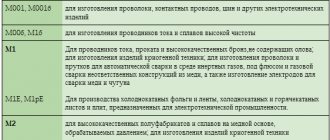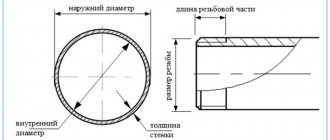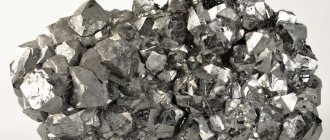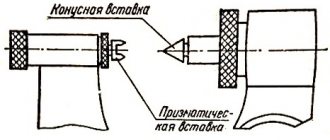Specific gravity is the ratio of the weight of a substance to the volume it occupies, while density is the ratio of the mass of a substance to the volume it occupies.
It is important to remember that weight and mass are different physical quantities. Mass means the amount of matter and is a characteristic of a physical object that determines its resistance to acceleration. In the International System of Units, mass is expressed in kilograms.
Weight is the force exerted by an object on a support that prevents it from falling (for example, the surface of the earth, a bathroom scale, a steelyard spring). Weight is determined by the product of the mass of an object and the acceleration of gravity (on planet Earth, the acceleration of gravity is 9.8 m/s 2 ). In the international system of units of measurement, weight is expressed in newtons.
Based on this, density is measured in kg/m3, and specific gravity in N/m3.
The concept of specific gravity is found in many areas of science and life. This term is used in physics, medicine, metallurgy, economics and sociology. It is difficult to expect that such diverse directions will be interpreted in the same way, so the definition and formula of specific gravity taken from a physics reference book will differ from the formulations found in an economics textbook. However, the essence remains the same - determining the role and significance of a certain part in relation to the whole.
The meaning of the term "specific"
We can talk about two interpretations, physical and statistical:
- In physics, this is the name given to a quantity measured in a unit of something. For example, let's take a room and calculate the amount of water vapor in it. Having obtained the value, A grams, we can say that the humidity here is A grams of water vapor for the whole room. Knowing the total amount of air in the room (B kg), we can find how much water is contained in one kilogram of air by finding out its specific humidity . One kilogram of room air contains A/B g/kg of water vapor. Thus, the word relative is synonymous with the term.
- In statistical sciences, this is the name given to a particular indicator taken relative to a certain whole. As an example, let’s take the country’s annual budget of 500 million and calculate the share of spending on sports. Let’s assume that 1 million rubles are allocated for sports—that’s 0.2% of all planned spending. Not the most significant budget item.
Densities of some gases[ | ]
Gas density, kg/m³ at .
| Nitrogen | 1,250 | Oxygen | 1,429 |
| Ammonia | 0,771 | Krypton | 3,743 |
| Argon | 1,784 | Xenon | 5,851 |
| Hydrogen | 0,090 | Methane | 0,717 |
| Water vapor (100 °C) | 0,598 | Neon | 0,900 |
| Air | 1,293 | Radon | 9,81 |
| Tungsten hexafluoride | 12,9 | Carbon dioxide | 1,977 |
| Helium | 0,178 | Chlorine | 3,164 |
| Dician | 2,38 | Ethylene | 1,260 |
To calculate the density of an arbitrary ideal gas under arbitrary conditions, you can use the formula derived from the equation of state of an ideal gas:[6]
ρ = p M mol RT {\displaystyle \rho ={\frac {pM_{mol}}{RT}}} ,
Where:
- p {\displaystyle p} - pressure,
- M mol {\displaystyle M_{mol}} — molar mass,
- R {\displaystyle R} is the universal gas constant, equal to approximately 8.314 J/(mol K)
- T {\displaystyle T} is thermodynamic temperature.
Physical Sciences
In physics, specific weight is called weight measured per unit volume of a homogeneous substance.
Weight in the SI system is indicated in Newtons (N), and volume is calculated in cubic meters. Thus, the unit of the required characteristic becomes Newton per cubic meter (N/cub.m). It follows that this value determines the force with which one cubic meter of the measured substance acts on the support.
Physical formula: U.v. = Weight of the object, N / Volume of the object, cubic meters. m .
Unlike mass, which simply characterizes an object, weight is a vector quantity, that is, it is a force that has a direction of application and describes the effect of the body on other objects. Under normal conditions on the surface of the Earth, the difference is imperceptible to us, not physicists. We often confuse these terms in conversation and are not at all worried about it. But it is still important to understand the fundamentally different meanings these concepts have.
Read also: Level device and purpose
If we use the mass of a body in the above formula, we get its specific gravity, or density. This parameter characterizes how much substance is contained in a unit volume and is measured in kg/cubic meter. m.
Body weight always remains the same, while weight can vary depending on the geographic latitude of the place and its altitude above sea level.
By representing the numerator of the fraction through the mass of the body multiplied by the acceleration of gravity, we can see the relationship between the two specific quantities:
U.V. = Object density * Gravity acceleration .
Thus, we can say that specific gravity relates to the density of a substance in the same way as its weight relates to mass, and this ratio is equal to the acceleration of gravity at a particular point on the Earth.
Density of some types of wood[ | ]
Wood density, g/cm³
| Balsa | 0,15 | Siberian fir | 0,39 |
| Sequoia evergreen | 0,41 | Spruce | 0,45 |
| Willow | 0,46 | Alder | 0,49 |
| Aspen | 0,51 | Pine | 0,52 |
| Linden | 0,53 | horse chestnut | 0,56 |
| Edible chestnut | 0,59 | Cypress | 0,60 |
| Bird cherry | 0,61 | Hazel | 0,63 |
| Walnut | 0,64 | Birch | 0,65 |
| Cherry | 0,66 | Smooth elm | 0,66 |
| Larch | 0,66 | Field maple | 0,67 |
| Teak | 0,67 | Beech | 0,68 |
| Pear | 0,69 | Oak | 0,69 |
| Switenia (Mahogany) | 0,70 | Sycamore | 0,70 |
| Zhoster (buckthorn) | 0,71 | Yew | 0,75 |
| Ash | 0,75 | Plum | 0,80 |
| Lilac | 0,80 | Hawthorn | 0,80 |
| Pecan (cariah) | 0,83 | Sandalwood | 0,90 |
| Boxwood | 0,96 | Ebony | 1,08 |
| Quebracho | 1,21 | Lignum vitae | 1,28 |
| Cork | 0,20 |
Application in medicine
In some cases, the desired characteristic is defined as a coefficient comparing the mass of a certain volume of a substance with the same volume of water at 4 °C. It is known that at this temperature pure distilled water has a specific gravity equal to unity. The more impurities, the more weight. Knowing this indicator, you can determine how high the concentration of substances in the liquid is.
This position is used in medicine when performing urine tests. The first formula given describes how to find the specific gravity of urine. To do this, you need to divide the weight of the sample by its volume.
Content
- 1 Formula for finding density
- 2 The case of granular and porous bodies
- 3 Dependence of density on temperature
- 4 Range of densities in nature
- 5 Densities of astronomical objects
- 6 Densities of some gases
- 7 Densities of some liquids
- 8 Density of some types of wood
- 9 Density of some metals
- 10 Density measurement
- 11 See also
- 12 Notes
- 13 Literature
- 14 Links
Economics and Social Sciences
In economics and social sciences, the term denotes the share of a particular factor in the overall structure. This concept is of great importance, as it allows us to judge the significance of a sector, its value, and its share in the whole direction.
Formula for share in economics: U.v. = The value of an individual table column / The sum of all table columns .
In this equation, the dividend and divisor are expressed in the same units of measurement, therefore, the desired quantity will be presented as a correct decimal fraction or percentage.
Similar calculations are carried out in economics, business activity, sociology, statistics and many other disciplines that require data analysis.
When calculating, it is important to understand two things:
- The denominator of the fraction is 100%, and the sum of the indicators for all columns of the table cannot exceed it. So, if we add up the percentage shares of all budget items, we get 100%, no more and no less.
- The result of the calculation cannot be negative, because it represents a fraction of the whole.
Read also: What are the main parts of a transformer?
Despite the fact that the two formulas above differ from each other and operate with different quantities, they still have something in common. In both cases, the weight of the object, its significance, influence on other objects and the situation as a whole are calculated.
Density of some metals[ | ]
The density values of metals can vary over a very wide range: from the lowest value for lithium, which is lighter than water, to the highest value for osmium, which is heavier than gold and platinum.
Density of metals, kg/m³
| Osmium | 22610[7] | Rhodium | 12410[8] | Chromium | 7190[9] |
| Iridium | 22560[10] | Palladium | 12020[11] | Germanium | 5320[12] |
| Plutonium | 19840[13] | Lead | 11350[14] | Aluminum | 2700[15] |
| Platinum | 19590[16] | Silver | 10500[17] | Beryllium | 1850[18] |
| Gold | 19300[14] | Nickel | 8910[19] | Rubidium | 1530[20] |
| Uranus | 19050[21] | Cobalt | 8860[22] | Sodium | 970[23] |
| Tantalum | 16650[24] | Copper | 8940[25] | Cesium | 1840[26] |
| Mercury | 13530[27] | Iron | 7870[28] | Potassium | 860[29] |
| Ruthenium | 12450[30] | Manganese | 7440[31] | Lithium | 530[32] |
Subscribe to RSS and you will receive information about site updates to your RSS channel!
Author: gidroadmin
Date of: 2008-12-08
A liquid is a continuous medium that has the property of fluidity, that is, it is capable of unlimitedly changing its shape under the influence of arbitrarily small forces, but unlike a gas, its density changes little when pressure changes.
In aeromechanics, the term “droplet liquid” is used to emphasize the difference between a liquid and a gas; the gas in these cases is called a “compressible liquid”.
Liquids can be ideal or real. Ideal - non-viscous liquids with absolute mobility, i.e. absence of frictional forces and tangential stresses and absolute immutability, and volume under the influence of external forces. Real - viscous liquids that have compressibility, resistance, tensile and shear forces and sufficient mobility, i.e. the presence of frictional forces and tangential stresses.
Real fluids can be Newtonian and non-Newtonian (Bingham). In Newtonian fluids, when one layer of fluid moves relative to another, the magnitude of the shear stress is proportional to the shear rate. At relative rest, these stresses are zero. This pattern was established by Newton in 1686, which is why these liquids (water, oil, gasoline, kerosene, glycerin, etc.) are called Newtonian liquids. Non-Newtonian fluids do not have great mobility and differ from Newtonian fluids by the presence of tangential stresses (internal friction) at rest.
Basic properties of liquids: density, specific gravity, viscosity, compressibility , etc.
Density ρ – mass of liquid per unit volume. For a homogeneous liquid
where m is the mass of liquid in volume V. The units of measurement of ρ in the CGS system are g/cm 3 , in the MKGSS system they are kgf s 2 /m 4 , and in the SI system they are kg/m 3 .
Specific gravity γ – weight of liquid per unit volume:
where G is the weight of the liquid. The units of measurement of γ in the CGS system are dyn/cm 3 , in the MKGSS system – kgf/m 3 , and in the SI system – N/m 3 .
Specific gravity and density are related by the dependence γ=ρ·g, where g is the acceleration of gravity.
Density and specific gravity of some technical fluids.
| Liquid | t, 0 C | ρ, kg/m 3 ; γ, kgf/m 3 | γ, N/m 3 | ρ, kgc s 2 /m 4 |
| Autol 10 | 20 | 920 | 9025 | 93,8 |
| Alcohol (anhydrous) | 20 | 795 | 7799 | 81,0 |
| Ammonia | -34 | 684 | 6710 | 69,7 |
| Aniline | 15 | 1004 | 9849 | 102 |
| Acetone | 15 | 790 | 7750 | 80,5 |
| Petrol | 15 | 680 – 740 | 6671 – 7259 | 69,3 – 75,4 |
| Bitumen | – | 930 – 950 | 9123 – 9320 | 94,8 – 96,8 |
| Distilled water | 4 | 1000 | 9810 | 102 |
| Sea water | 4 | 1020-1030 | 10006-10104 | 104-105 |
| Glycyrin (anhydrous) | 15 | 1270 | 11772 | 129 |
| Tar | 15 | 930-950 | 9123-9320 | 94,8-96,8 |
| Coal tar | 15 | 1200 | 12459 | 122 |
| Kerosene | 15 | 790 – 820 | 7750-8044 | 80,5 – 93,5 |
| Fuel oil | 15 | 890 – 940 | 8731 – 9221 | 90,7 – 95,8 |
| Oil: | ||||
| -vaseline | 20 | 860 – 890 | 8437 – 8731 | 87,7 – 90,7 |
| -industrial 12 | 20 | 876 – 891 | 8594 – 8741 | 89,3 – 90,8 |
| -industrial 20 | 20 | 881 – 901 | 8643 – 8839 | 89,8 – 93,3 |
| -industrial 30 | 20 | 886 – 916 | 8692 – 8986 | 90,3 – 93,4 |
| -industrial 45 and 50 | 20 | 890 – 930 | 8731 – 9123 | 90,7 – 94,8 |
| -industrial 45 and 50 | 20 | 890 – 930 | 8731 – 9123 | 90,7 – 94,8 |
| -castor | 20 | 960 | 9418 | 97,8 |
| -machine | 20 | 898 | 8809 | 91,5 |
| -transformer | 20 | 887 – 896 | 8701 – 8790 | 90,4 – 91,3 |
| -turbine 30 and 32 | 20 | 894 – 904 | 8770 – 8868 | 91,1 – 92,1 |
| Whole milk | 20 | 1029 | 10094 | 103 |
| Natural oil | 15 | 700 – 900 | 6867 – 8829 | 71,4 – 91,7 |
| Beer | 15 | 1040 | 10202 | 106 |
| Mercury | 20 | 13546 | 132886 | 1381 |
| Methyl alcohol | 15 | 810 | 7946 | 82,6 |
| Ethanol | 15-18 | 790 | 7750 | 80,5 |
| Molten cast iron | 17 | 1210 | 11870 | 123 |
Read also: How to measure insulation resistance with a multimeter
Density of water and mercury at different temperatures.
Source: Vilner Ya.M. Reference manual on hydraulics, hydraulic machines and hydraulic drives.
Views: 164260
Comments on this article!!
Comment added by: mqsqt Date: 2011-09-03
Comment added by: Bashtag Date: 2012-10-29
Comment added by: Sanya Date: 2013-11-12
Comment added by: Ir Date: 2014-01-15
Comment added by: ir Date: 2014-04-28
Comment added by: lelik Date: 2014-10-20
Nice way to go
Comment added by: sens Date: 2014-10-23
Thank you very much for the table. It was very useful. ))))
Comment added by: Yuri Date: 2014-12-30
Comment added by: edld Date: 2015-01-28
Comment added by: Vitaly Date: 2018-05-14
Thank you very much for the material
Add your comment
| Similar articles! | |
| Viscosity of liquids | Viscosity of water, milk, gasoline, oil, alcohol | |
| Hydrostatic pressure. Pascal's law. | |
| Bernoulli's equation - the basic equation of hydraulics | |
| Compressibility of liquids | |
| Laminar and turbulent fluid flow regime | |
| The most popular articles on the site! | |
| Conversion of units of measurements. Pressure unit converter | |
| Viscosity of liquids | Viscosity of water, milk, gasoline, oil, alcohol | |
| Density and specific gravity of liquids | Density of water, oil, alcohol, kerosene, gasoline and petroleum | |
| Hydraulic calculation of pipelines | |
| Bernoulli's equation - the basic equation of hydraulics | |
| Laminar and turbulent fluid flow regime | |
| Hydrostatic pressure. Pascal's law. | |
| Thermal expansion of liquids | |
| Compressibility of liquids | |
| History of hydraulics. History of the development of hydraulics. Part 1. From ancient Greece to the mid-18th century. | |
Densities of some liquids[ | ]
| The section lacks links to sources. Information must be verifiable or it may be deleted. You can edit the article to add links to authoritative sources. This mark was set on January 4, 2022 . |
Density of liquids, kg/m³
| Petrol | 710 | Milk | 1040 |
| Water (4 °C) | 1000 | Mercury (0 °C) | 13600 |
| Kerosene | 820 | Diethyl ether | 714 |
| Glycerol | 1260 | Ethanol | 789 |
| Sea water | 1030 | Turpentine | 860 |
| Olive oil | 920 | Acetone | 792 |
| Motor oil | 910 | Sulfuric acid | 1835 |
| Oil | 550—1050 | Liquid hydrogen (−253 °C) | 70 |
Links[ | ]
- Online interactive table of substance densities (Russian)
- Detailed table of density values for common liquids (Russian)
- Lesson on the topic “Density of matter”
| Dictionaries and encyclopedias |
|
| In bibliographic catalogs |
|
Density measurement[ | ]
For density measurements the following are used:
- Pycnometer - a device for measuring true density
- Various types of hydrometers are liquid density meters.
- Kaczynski's drill and Seidelman's drill are instruments for measuring soil density.
- A vibration densitometer is a device for measuring the density of liquids and gases under pressure.
- Hydrostatic weighing method.
Bone densitometry is a procedure for measuring the density of human bone tissue.
| This section is not completed. You will help the project by correcting and expanding it. |
Notes[ | ]
- It is also implied that the region contracts to a point, that is, not only its volume tends to zero (which could happen not only when the region contracts to a point, but, for example, to a segment), but also its diameter (maximum linear size).
- Agekyan T. A.
Expansion of the Universe. Model of the Universe // Stars, galaxies, Metagalaxy. 3rd ed. / Ed. A. B. Vasilyeva. - M.: Nauka, 1982. - 416 p. — P. 249. - Planetary Fact Sheet
- Sun Fact Sheet
- Stern, S. A., et al.
The Pluto system: Initial results from its exploration by New Horizons (English) // Science: journal. — 2015. — Vol. 350, no. 6258. - P. 249-352. - doi:10.1126/science.aad1815. - MECHANICS. MOLECULAR PHYSICS. Educational and methodological manual for laboratory work No. 1-51, 1-61, 1-71, 1-72 (undefined)
. St. Petersburg State Technological University of Plant Polymers (2014). Date accessed: January 4, 2019. - Krebs, 2006, p. 158.
- Krebs, 2006, p. 136.
- Krebs, 2006, p. 96.
- Krebs, 2006, p. 160.
- Krebs, 2006, p. 138.
- Krebs, 2006, p. 198.
- Krebs, 2006, p. 319.
- ↑ 12
Krebs, 2006, p. 165. - Krebs, 2006, p. 179.
- Krebs, 2006, p. 163.
- Krebs, 2006, p. 141.
- Krebs, 2006, p. 67.
- Krebs, 2006, p. 108.
- Krebs, 2006, p. 57.
- Krebs, 2006, p. 313.
- Krebs, 2006, p. 105.
- Krebs, 2006, p. 50.
- Krebs, 2006, p. 151.
- Krebs, 2006, p. 111.
- Krebs, 2006, p. 60.
- Krebs, 2006, p. 168.
- Krebs, 2006, p. 101.
- Krebs, 2006, p. 54.
- Krebs, 2006, p. 134.
- Krebs, 2006, p. 98.
- Krebs, 2006, p. 47.











